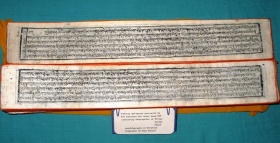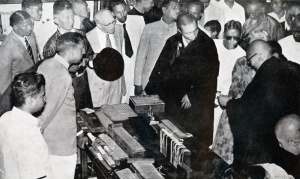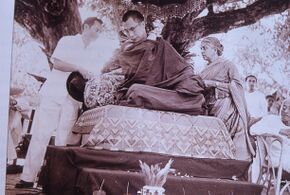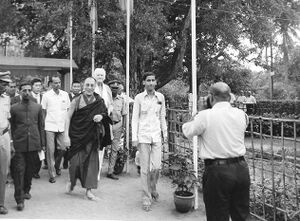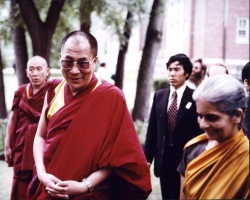Tenzin Gyatso, the XIV Dalai Lama
Tenzin Gyatso, His Holiness the XIV Dalai Lama of Tibet, is the spiritual and temporal leader of the six million Tibetan people. He is an internationally respected leader, author and speaker. He is a Nobel laureate and was awarded the U.S. Congressional Gold Medal of Honor in 2007, our country’s highest civilian award "in recognition of his many outstanding contributions to peace, non-violence, human rights and religious understanding."
According to Buddhist scholar Glenn Mullin,
What is for me most impressive about the Dalai Lama is that he embodies the grandeur of enlightenment while retaining the ability to express its simplicity. He works twenty hours a day to bring peace and spiritual awareness into this world, but is oblivious to all that he does... He takes what he does as easily, lightly, and naturally as the breathing process.[1]
Early life
He was born Lhamo Dhondup on July 6, 1935, in a small village called Taktser in northeastern Tibet. Born to a peasant family, His Holiness was recognized at the age of two. In accordance with Tibetan tradition, as the reincarnation of his predecessor the 13th Dalai Lama, His Holiness is an incarnation of Avalokiteśvara, the Buddha of Compassion.
The Dalai Lama began his education at the age of six and completed the Geshe Lharampa Degree (Doctorate in Buddhist Philosophy) when he was 25 in 1959. At 24, he took the preliminary examinations at each of the three monastic universities: Drepung, Sera, and Ganden, outside Lhasa, the Tibetan capital city. The final examination was conducted in the Jokhang Temple in Lhasaduring the annual Monlam Chenmo or the great Prayer festival, held in the first month of the Tibetan calendar year. In the morning, he was examined by 30 scholars on logic. In the afternoon, he debated with 15 scholars on the subject of the Middle Path, and in the evening 35 scholars tested his knowledge or the canon of monastic discipline and the study of metaphysics. His Holiness passed the examination with honors, conducted before the 20,000 monk scholars. In addition to Buddhist subjects, he studied English, Sciences, Geography and Mathematics.
Leadership Responsibilities
In 1950, at 15, His Holiness was called upon to assume full political responsibility (head of the state and Government) when Tibet was threatened by the might of China. In 1954, he went to Beijing to hold peace talks with Mao Tsetung and other Chinese leaders including Chou En-Lai and Deng Xiaoping. In 1956, while visiting India to attend the 2500th birth anniversary of the Buddha, he had a series of meetings with Indian Prime Minister Nehru and Premier Chou about the deteriorating situation in Tibet. His efforts to bring about a peaceful solution to the Sino-Tibetan problem were thwarted by Beijing’s ruthless policy in eastern Tibet, which ignited a popular uprising. This resistance movement spread to other parts of the country, and on March 10, 1959, the capital of Tibet, Lhasa exploded with a massive demonstration. The demonstrating Tibetans called on China to leave Tibet and reaffirmed Tibet’s independence. His Holiness escaped to India where he was given political asylum. Some 80,000 Tibetan refugees at the time managed to follow His Holiness into exile. Today there are more than 120,000 Tibetan refugees in India, Nepal, Bhutan, and in the West. Since 1960, His Holiness has resided in Dharamsala, a small town in Northern India, aptly known as “Little Lhasa,” the seat of the Tibetan Government-in-exile.
In the early years of exile, His Holiness appealed to the United Nations on the question of Tibet, resulting in three resolutions adopted by the General Assembly in 1959, 1961, and 1965, calling on China to respect the human rights of Tibetans and their right to self-determination.
With the re-establishment of the Tibetan Government in India, His Holiness saw that his immediate and urgent task was to preserve Tibetan culture. He founded 53 large-scale agricultural settlements for the refugees to live on. As an economic base developed, he oversaw the creation of an autonomous Tibetan school system (there are over 80 Tibetan schools in India and Nepal today) to raise refugee children with full knowledge of their language, history, religion and culture. The Tibetan Institute of Performing Arts was established in 1959 while the Central Institute of Higher Tibetan Studies became a university for Tibetans in India. He inaugurated several cultural institutes to preserve Tibet’s arts and sciences and helped re-establish more than 200 monasteries to keep alive the vast corpus of Buddhist teachings, the essence of the Tibetan spirit.
In 1963, His Holiness promulgated a democratic constitution, based on Buddhist principles and the Universal Declaration of Human Rights, as a model for a future free Tibet. Since then, His Holiness has been the most rigorous advocate for the refugees’ own democratic experiment, while consistently reaffirming his desire not to hold political office once Tibet regains its independence. His Holiness continues to present new initiatives to resolve the Tibetan issue. At the Human Rights Caucus of the US Congress in 1987, he proposed a Five Point Peace Plan as a first step toward resolving the future status of Tibet. This plan calls for the designation of Tibet as a zone of non-violence, and end to the massive transfer of Chinese into Tibet, restoration of fundamental human rights and democratic freedoms, and the abandonment of China’s use of Tibet for nuclear weapons production and the dumping of nuclear waste, as well as urging “earnest negotiations” on the future of Tibet.
In Strasbourg, France on June 15, 1988, he elaborated on this Five Point Peace Pla' and proposed the creation of a self-governing democratic Tibet “in association with the People’s Republic of China.” In his address, the Dalai Lama said that this represented “the most realistic means by which to re-establish Tibet’s separate identity and restore the fundamental rights of the Tibetan people while accommodating China’s own interests.” His Holiness emphasized that “whatever the outcome of the negotiations with the Chinese may be, the Tibetan people themselves must be the ultimate deciding authority.”
However, on September 2, 1991 (Tibetan Democracy Day), the Tibetan Government-in-exile released a statement declaring the Strasbourg Proposal no longer binding and added: “His Holiness the Dalai Lama made it very clear in his statement on 10th March this year that because of the closed and negative attitude of the present Chinese leadership he felt that his personal commitment to the ideas expressed in the Strasbourg proposal became ineffectual, and that if there was no new initiatives from the Chinese he would consider himself free of any obligation to the proposals he had made in his Strasbourg address. He, however, remains firmly committed to the path of non-violence and in finding a solution to the Tibetan issue through negotiations and understanding. Under these circumstances His Holiness the Dalai Lama no longer feels obligated or bound to pursue the Strasbourg Proposal as a basis for finding a peaceful solution to the Tibetan problem.”
Since 1967, His Holiness has initiated a series of journeys that have taken him to some 42 nations. In February, 1990, His Holiness was invited to Czechoslovakia by President Vaclav Havel. President Havel and His Holiness issued a joint statement urging “all politicians to rid themselves of the restrictions of particular private or group interests and to lead their minds by their conscience and their feeling and responsibility for truth and justice.” In 1991, His Holiness met President George Bush of the United States, Neil Kinnock, the British Opposition Leader, the Swiss and French Foreign Ministers, the Chancellor and President of Austria, as well as other senior foreign government officials. In meetings with political, religious, cultural and business leaders, as well as before large audiences at universities, churches and town halls, he has spoken of his belief in the oneness of the human family and the need for each individual to develop a sense of universal responsibility.
His Holiness said, “We are living today in an interdependent world. One nation’s problems can no longer be solved by itself. Without a sense of universal responsibility, our very survival is in danger. Basically, universal responsibility is feeling for other people’s suffering just as we feel our own. I have always believed in the need for better understanding, closer cooperation and greater respect among the various nations of the world. Besides, I feel that love and compassion are the moral fabric of world peace.”
His Holiness met with the late Pope Paul VI at the Vatican in 1973, and with His Holiness Pope John Paul II in 1980, 1982, 1986, 1988 and 1990. At a press conference in Rome, His Holiness the Dalai Lama outlined his hopes for the meeting with John Paul II: “We live in a period of great crisis. It is not possible to find peace without security and harmony between peoples. For this reason, I look forward with faith and hope to my meeting with the Holy Father; to an exchange of ideas and feelings, and to his suggestions, so as to open the door to a progressive harmony between peoples.”
In 1981, His Holiness talked with the Archbishop of Canterbury, Dr. Robert Runcie, and with other leaders of the Anglican Church in London. He also met with leaders of the Roman Catholic and Jewish communities and spoke at an interfaith service held in his honor by the World Congress of Faiths. In October 1989, during a dialogue with eight rabbis and scholars from the United States inDharamsala, India, His Holiness remarked: “When we became refugees, we knew that our struggle would not be easy; it would take a long time, generations. Very often we would refer to the Jewish people, how they kept their identity and faith despite such hardship and so much suffering. And, when external conditions were ripe they were ready to rebuild their nation. So you see, there are many things to learn from our Jewish brothers and sisters.”
His talks in other forums focused on the commonality of faiths and the need for unity among different religions: “I always believe that it is much better to have a variety of religions, a variety of philosophies, rather than one single religion of philosophy. This is necessary because of the different mental dispositions of each human being. Each religion has certain unique ideas to techniques, and learning about them can only enrich one’s own faith.” In 1993, he participated in the Parliament of the World's Religions, giving a major address on the closing day.
Early visits to the Theosophical Society in Adyar
The Theosophical Society based in Adyar, Chennai, India has a long and warm relationship with His Holiness the XIVth Dalai Lama.
1956 visit to Adyar
The young Dalai Lama traveled to India in 1956 to celebrate the birth of Buddha. He was accompanied by the Panchen Lama and a large party of Tibetan Buddhists. During his tour he visited the international headquarters of the Theosophical Society in Adyar, Chennai (formerly Madras). On December 18th, he presented three Tibetan manuscripts to the Adyar Library and Research Centre. Radha Burnier described the three xylographs as biographies of Pandit Atisha Dipankara; the Indian Pandit Thelo and his disciple Narope of Nalanda; and the Tibetan disciples Mila and Marpa.[2]
Later His Holiness wrote that the Theosophists’ openness to many faith traditions had changed his views toward religious pluralism. He wrote:
Looking back to this trip in 1956, I realize that my visit to the Theosophical Society in Chennai (then Madras) left a powerful impression. There I was first directly exposed to people, and to a movement, that attempted to bring together the wisdom of the world’s spiritual traditions as well as science. I felt among the members a sense of tremendous openness to the world’s great religions and a genuine embracing of pluralism.
When I returned to Tibet in 1957, after more than three months in what was a most amazing country for a young Tibetan monk, I was a changed man. I could no longer live in the comfort of an exclusivist standpoint that takes Buddhism to be the only true religion.
When tragic political circumstances in 1959 forced me into exile in India to live as a refugee, I was paradoxically afforded the freedom to deepen my personal journey of understanding and engagement with the world’s faith traditions.[3]
The following is a report about this visit published in The Theosophist:
During their stay in Madras, Their Holinesses the Dalai Lama and the Panchen Lama of Tibet, who are in India as guests of the Government for the celebration of Buddha Jayanti, came to visit Headquarters. They were accompanied by a party of about sixty fellow countrymen.
Arriving from Kalākshetra, the distinguished guests were first taken to the Banyan Tree and from there to the Headquarters Hall, where officers of the Society received and garlanded them and members and residents witnessed and enthusiastically supported the welcoming.
The Dalai Lama and the Panchen Lama were shown through the Adyar Library, with its unique collection of old manuscripts, and then visited the Buddhist Shrine and the sapling of the famous Bo Tree at Gaya, planted opposite the Shrine in 1950, and now a tall tree.
This is the first visit by the Dalai Lama and the Panchen Lama to India, and it was a great privilege and honor for members at Adyar to participate in this function at Headquarters.[4]
1959 visit to Adyar
Another visit to Adyar (campus) followed on December 20, 1959. That was the year that His Holiness escaped from Chinese authorities in Tibet, and took up residence in Dharamsala in the north of India. At Adyar (campus) he was greeted by about 300 guests, and honored with a high tea of western and Indian foods. Mr. Nilakanta Sri Ram, the international President of the Society, was his host. The following is a report written about the occasion:
Of recent functions held under the Banyan Tree, one that will be long remembered is the tea party given by the President of The Theosophical Society, Mr. N. Sri Ram, for His Holiness the Dalai Lama of Tibet, on December 20, 1959. Members of The Theosophical Society who had arrived early for the Convention as well as residents of the compound were invited so that there were more than two hundred guests present. At five o’clock the President welcomed the Dalai Lama by garlanding him at the trilithon which serves as a formal entrance to the Banyan Tree. His Holiness the Dalai Lama with his interpreter and immediate party, the President and other distinguished guests then moved slowly to the tea-table area, His Holiness stopping every few steps for an introduction, all of which was most helpful to the amateur photographers. After the tea itself, which on this occasion was a high one of both western and Indian food, the President formally welcomed and presented the Dalai Lama to the assembled guests. In company with the President, His Holiness then moved graciously from table to table greeting each guest individually. It was all a very happy and festive occasion, underlined by a spiritual quality which was no doubt deepened by the fact that this visit of the Dalai Lama was made in his private capacity and was therefore more direct and intimate than it might otherwise have been.[5]
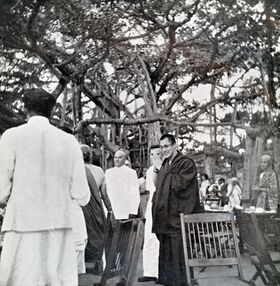 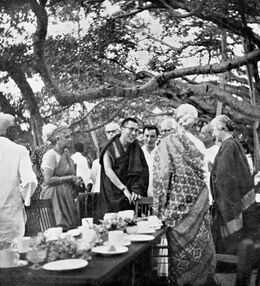
|
Other connections with the Theosophical Society
There have been numerous additional connections between the Theosophical Society and His Holiness. At least 150 articles by or about the Dalai Lama have been printed in Theosophical journals, and he has been mentioned or quoted in hundreds more.
1972 visit in Dharamsala
In 1972, two representatives of the Theosophical Society in America visited His Holiness in Dharamsala, India. President Joy Mills and Helen Zahara, senior editor of the Theosophical Publishing House, had an audience on December 15. Joy Mills had the idea of publishing the Dalai Lama's book The Opening of the Wisdom-Eye, which was then only available in South Asia. Miss Mills spoke of this in an interview by Cynthia Overweg:
"We were able to get the rights to publish the Dalai Lama's book, and since we already had a trip planned to Adyar, Helen and I wondered if we could meet with his Holiness," Joy recalls. They made arrangements through the Office of Tibet in New York, flew into Delhi, took the train north, and then hired a taxi to take them to Dharamsala.
When they arrived at the Dalai Lama's home, they barely had a moment to gather their thoughts when his Holiness greeted them with what Joy describes as "that wonderful smile." She recalls that Helen made the statement that H.P. Blavatsky had introduced the inner side of Buddhism to the Western world. "What did she write?" asked the Dalai Lama.
"The Voice of the Silence," Helen answered. Directing his next question to Joy, he asked, "What is the essence of The Voice of the Silence?" At first, Joy couldn't think. She wondered how she could express the book in a brief way. "Well," she said finally, "it discusses the Paramitas," the six "perfections" of Mahayana Buddhism. The Dalai Lama seemed genuinely excited. "Ah, then it is accurate. It is true." Joy was thrilled to be able to introduce the Dalai Lama to HPB's great little book, and the meeting is one of her most cherished memories.[6]
Joy Mills then invited the Dalai Lama to speak at the Theosophical Society in America headquarters, and that led to his visit to the Olcott campus in Wheaton, Illinois nine years later. Here are photographs taken by Miss Zahara during their visit:
1973 meetings
In 1973, His Holiness toured Europe for six weeks and met with adherents of many religions, including Theosophists. In the Netherlands, he stayed at St. Michael’s Theosophical Center in Huizen, and participated in a panel discussion in Besant Hall.
1975 Theosophical Society centennial
In preparing for the 1975 centennial of the Theosophical Society, president John B. S. Coats visited Dharamsala to invite the Dalai Lama to the event:
I had over an hours talk with the Dalai Lama during which, at my invitation, he agreed to come to the Convention here and deliver a talk for us.[7]
Theosophists from all over the world gathered at a convention in Adyar to celebrate the centennial of the founding of the Theosophical Society. The Dalai Lama spoke in a public lecture on December 21 on the subject of "Compassion and Mental Development."
1980 visit to Varanasi
On January 29, 1980, His Holiness visited the headquarters of the Theosophical Society in India, located at Varanasi.[8]
1981 visit to Wheaton, Illinois
During his American tour in 1981, the Dalai Lama stayed for two days at the headquarters of the Theosophical Society in America, located in Wheaton, Illinois. He was accompanied by a translator and security details from the Tibetan Government-in-exile, the Government of India, and the Illinois State Police. TSA President Dora Kunz and International Theosophical Society President Radha Burnier hosted his visit. On July 21 he gave a talk to members on "Buddha Nature" in a tent on the lawn. That evening he delivered a public address, called "Universal Compassion and Global Crisis," at nearby Wheaton North High School. He gave Mrs. Kunz a thanka that hangs in the Meditation Room of the headquarters building.
1982 visit to Brisbane, Australia
Betsan Coats, the wife of John B. S. Coats, helped to organize the Dalai Lama's first tour to Australia in 1982. While in Brisbane, he personally gave her an embroidered cloth:[9][10]
1988 visit to Varanasi
On January 29, 1988, as in 1980, the Dalai Lama paid a visit to the Varanasi headquarters of the Indian Section of the Theosophical Society.[11]
1989 Preface to The Voice of the Silence
Helena Petrovna Blavatsky's classic work The Voice of the Silence was reissued in a centennial edition by Concord grove Press. The Dalai Lama wrote a foreword about his history with the Theosophical Society and significance of this book.
1990 lecture at Adyar
On December 26, 1990, on the opening day of the 115th International Convention, His Holiness delivered the Besant Lecture. That date celebrated the Centenary Convention of the Indian Section. He also released the book, In Honour of Dr. Annie Besant.[12]
2010 meeting in St. Louis
In May 2010, TSA President Betty Bland and Vice President Tim Boyd travelled to Cedar Falls, Iowa for an audience with the Dalai Lama. Their scheduled ten minutes with His Holiness stretched into thirty minutes, culminating with an agreement to plan an event in Chicago under TSA sponsorship. The following is an account of the visit by Betty Bland:
We packed our bags again for a trip to Iowa for a special audience with His Holiness the Dalai Lama. Although Tim and I had been expecting this auspicious event, we were not given an indication of exactly when or where until just a week before, while we were still at Krotona. Tim and I, accompanied by our spouses, Lily and David, were also fortunate to travel with Rinchen Dharlo of the New York Tibet Fund office. Rinchen flew in and out of Chicago and joined the four of us in the van for the five-hour road trip to Cedar Falls, the home of University of Northern Iowa (UNI), venue of His Holiness’ visit. We were treated to excellent seats at the several events there and were able to meet the Tibetan students who were at UNI under special scholarship arrangement.
We had been told that we would have only ten minutes with His Holiness but, through his gracious interest, our visit extended to thirty minutes. One of the first things he said was how well disposed he was to the Theosophical Society and how it had influenced his thinking as early as 1956, when he was invited to a Buddhist conference in India. As a serious young practicing monk, his contacts with Theosophists during that meeting opened his eyes to "the fact that Buddhism was not the only true religion."
Theosophy broadened his horizons at a critical time as he started along his path toward becoming a world leader in the area of interreligious communications and understanding. When approached concerning TSA’s possible sponsorship of an event in Chicago, he paused for only a moment before replying, "Yes, I will give you two days next year." Needless to say, we were ecstatic! Tim and I are now anxiously awaiting information about the dates and will keep you informed, although I must warn you the "next year" seems to have meant the next year in planning, and that the event will most likely occur in 2012.[13]
2011 events in Chicago
Interfaith dialogue was the major theme of HH Dalai Lama's events that were sponsored by the Theosophical Society in America, in Chicago. The UIC (University of Chicago at Illinois) Pavilion was the venue for the sold-out public lecture on July 17th, 2011. The Dalai Lama spoke on "Bridging the Faith Divide" to a crowd of 8,000 people.
The next day a panel discussion was held for Theosophical Society members and invited guests at the Harris Theater for Music and Dance in Chicago. The event was called "Building Bridges: Religious Leaders in Conversation with the Dalai Lama". Mr. Eboo Patel, the founder and executive director of the Interfaith Youth Core (a Chicago-based international nonprofit that aims to promote interfaith cooperation), held a brief interview with His Holiness before bringing on a panel of other religious leaders. They were Rabbi Michael Lerner, editor of the Jewish interfaith magazine Tikkun; Dr. Ingrid Mattson, Hartford Seminary Professor of Islamic Studies and Christian-Muslim Relations; and Rev. Peg Chemberlin, executive director of the Minnesota Council of Churches. Journalist Bill Curtis served as moderator.
TSA President Tim Boyd wrote about the fundraising aspect of this event:
When the Dalai Lama agreed to allow the Theosophical Society in America to host his visit to Chicago, we made a determination that all of the proceeds from the event would be given away. We had targeted the Tibet Fund to be the recipient of those funds. The Tibet Fund is a US-based 501c3 charitable organization founded by the Dalai Lama to serve the Tibetan refugee community...
In all, we received $225,000 in cash contributions. We also received numerous in-kind contributions that enabled us to reduce costs and produce an event of the highest caliber. Even a partial list of the noncash donations is long: the board of directors for the Harris Theater waived its rental fee; the creative team at Ogilvy and Mather developed original artwork for two outstanding posters, then paid for the printing of them (sale of these posters and tee-shirts using the images brought in almost $12,000); the actress, Jennifer Beals, gave tirelessly of her time and connections in promoting the event (through her, Illinois governor Pat Quinn attended); a team of photographers donated their services to document the event; the CEO of iClips, a company that provides streaming video messaging, sent a crew from St. Louis consisting of three cameramen and a producer to livestream the events on the Internet, they then turned over all of their footage to the TSA for the production of the DVDs and video we have produced; a private jet seating twelve people was donated to bring His Holiness from Washington, DC to Chicago on the morning of the event; the Dalai Lama's hotel suite at one of Chicago's premiere locations was donated; and on and on.
The bottom line is that on September 19, 2011, I traveled to New York City. It was a proud moment when, on behalf of the Theosophical Society in America, I presented checks for slightly more than $400,000 to the Tibet Fund and the Dalai Lama Trust!
When Mr. Boyd asked His Holiness whether he would like to be a member of the TSA, the Dalai Lama readily agreed, and was awarded a certificate for life membership dated July 18, 2011.[14]
Recognition and Awards
So many awards and honors have been awarded to the Dalai Lama that Wikipedia has a lengthy article detailing them. Since his first visit to the west in 1973, His Holiness’s reputation as a scholar and man of peace has grown steadily. In recent years, a number of universities and institutions in the world have conferred Peace Awards, honorary doctorates and fellowships on His Holiness in recognition of distinguished writings in Buddhist philosophy and of his distinguished leadership in the service of freedom, peace and nonviolence. One such Doctorate was conferred by Seattle University,Washington, USA.
The following extract from the University’s citation reflects a widely held view of His Holiness’ stature: “In the realm of mind and spirit, you have distinguished yourself in the rigorous academic tradition of Buddhist universities, earning the Doctor’s degree with the highest honors at the age of 25. In the midst of governmental and diplomatic affairs you nonetheless found time to teach and record in writing your keen insights in philosophy and the meaning of the contemplative life in the modern world. “Your books represent a significant contribution not only to the vast body of Buddhist literature, but to the ecumenical dialogue of the great religions of the world. Your own dedication to the contemplative life of the Buddhist monk has won the admiration and awe not only of the Buddhist, but of Christian contemplatives as well, including the contemplative monk Thomas Merton, whose friendship and conversation with you were mutually cherished.”[15]
In presenting the Raoul Wallenberg Congressional Human Rights Award, Congressman Tom Lantos said, “His Holiness the Dalai Lama’s courageous struggle has distinguished him as a leading proponent of human rights and world peace. His ongoing efforts to end the suffering of the Tibetan people through peaceful negotiations and reconciliation have required enormous courage and sacrifice.”
The Nobel Peace Prize
The Norwegian Nobel Committee’s decision to award the 1989 Peace Prize to His Holiness the Dalai Lama won world wide praise and applause. In its citation, “the committee wants to emphasize the fact that the Dalai Lama in his struggle for the liberation of Tibet has consistently opposed the use of violence. He has instead advocated peaceful solutions based upon tolerance and mutual respect in order to preserve the historical and cultural heritage of his people. The Dalai Lama has developed his philosophy of peace from a great reverence for all things living and upon the concept of universal responsibility embracing all mankind as well as nature. In the opinion of the Committee the Dalai Lama has come forward with constructive and forward-looking proposals for the solution of international conflicts, human rights issues and global environmental problems.”
On December 10, 1989, in Oslo, Norway, His Holiness accepted the prize on behalf of the oppressed everywhere and all those who struggle for freedom and work for world peace and the people of Tibet. In his remarks, he said, “The prize reaffirms our conviction that with truth, courage and determination as our weapons, Tibet will be liberated. Our struggle must remain nonviolent and free of hatred.”
He also had a message of encouragement for the democracy movement in China. “In China the popular movement for democracy was crushed by brutal force in June of this year. But I do not believe the demonstrations were in vain, because the spirit of freedom was rekindled among the Chinese people and China cannot escape the impact of this spirit of freedom sweeping in many parts of the world. The brave students and their supporters showed the Chinese leadership and the world the human face of that great nation.”
Congressional Gold Medal
In October 2007, His Holiness the Fourteenth Dalai Lama was awarded the Congressional Gold Medal in recognition of his advocacy of peace, tolerance, human rights, non-violence, and compassion throughout the world. “The Dalai Lama is a worthy recipient of the Congressional Gold Medal. He is one of the world’s greatest religious leaders and has used human compassion, courage and conviction as his tools in carving a path for peace. For half a century, he has struggled to better the lives of the Tibetan people. In doing so, he has been a shining light to all those fighting for freedom around the world,” Senator Feinstein said. The “Fourteenth Dalai Lama Congressional Gold Medal Act” was introduced in the House by Representatives Ileana Ros-Lehtinen (R-Fla.) and Tom Lantos (D-Calif.).
Writings
The Dalai Lama has written or coauthored dozens of books that have been published in many languages. He has often written for periodicals as well. At least 150 articles by or about the Dalai Lama have been printed in Theosophical journals, and he has been mentioned or quoted in hundreds more.
- Publications list in Wikipedia is an extensive compilation of titles.
- Dalailama.com/books is an official website offering a large selection of books, videos, and other materials.
Publications by the Theosophical Publishing House
The Opening of the Wisdom-Eye, one of the Dalai Lama’s earliest books, is an overview of the essence of Buddhist teachings. The first English translation was produced in 1966 by the Theosophical Publishing House under the imprint of Quest Books. A new paperback edition was printed in 1981 with the assistance of The Kern Foundation.
See also
Additional resources
- "Tibet and the Dalai Lama" public lecture by Rukmini Devi, delivered at the 1960 convention of the Theosophical Society in America.
- "The Dalai Lama of Tibet Visits the West" by Joyce Murdoch. Reprinted from The Theosophist, January, 1974.
- "The Best of the Dalai Lama: Life, Quotes, Teachings, and Books" at Lions Roar: Buddhist Wisdom for Our Time website. September 17, 2017.
- Dalai Lama in Theosophy World.
Notes
- ↑ Glenn Mullin, "Personal Glimpses" The Quest 6 no.4 (January 1993), 95.
- ↑ Radha Burnier, The Theosophist 78 no.5 (February, 1957), 361.
- ↑ Tenzin Gyatso, Toward a True Kinship of Faiths (New York: Doubleday Religion/Random House, 2010), 6.
- ↑ Recording Secretary [Emma Hunt], "Dalai Lama and Panchen Lama Visit Adyar" The Theosophist 78 no.4 (January, 1957), 283-284.
- ↑ Caroline Tess, "The Banyan Tree at Adyar" The Theosophist 81 no.6 (June 1960), 172.
- ↑ Cynthia Overweg "Joy Mills: An Evolutionary Journey" Quest 100 no.2 (April 2012), 50-51, 53-55.
- ↑ John B. S. Coats letter to Charlie Chesrow. July 17, 1975. Chesrow Family Collection. Records Series 25.23. Theosophical Society in America Archives.
- ↑ C. V. Agarwal, The Buddhist and the Theosophical Movements, 1873-2001 (Varanasi: Maha Bodhi Society of India, 2001 and Adyar, Chennai, India: Theosophical Publishing House, 2001), 60.
- ↑ Chris Cook email to Archives Department. March 8, 2020. Theosophical Society in America Archives.
- ↑ "Dalai Lama in Brisbane" Brisbane Times June 13, 2007,
- ↑ C. V. Agarwal, 60.
- ↑ C. V. Agarwal, 60.
- ↑ Betty Bland, "President's Diary" Quest 98 no.4 (Fall 2010), 154.
- ↑ Tim Boyd, "President's Diary" Quest 99 no.4 (October, 2011), 155.
- ↑ "Biography" in Office of Tibet website.



